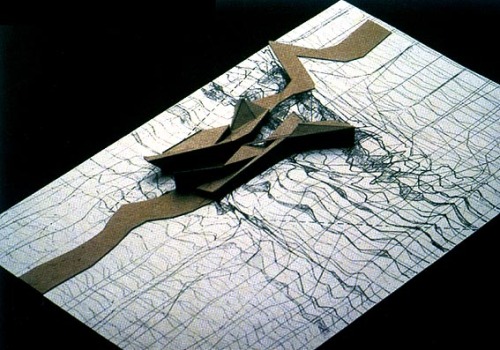Peter Eisenman
1932 births | Alumni of Trinity College, Cambridge | American architects | American architecture writers | Architectural theoreticians | Cornell University alumni | Deconstructivism | Jewish architects | Living people | Members of the American Academy of Arts and Letters | Postmodern architects | People from Newark, New Jersey
Basing his scheme for architectural design on theory drawn from outside existing architectural dogma, most notably from philosophy and linguistics, Eisenman has developed increasingly complex formulations regarding the architectural design process, especially in regards to the role of structure in contemporary society. With references to rhetorical strategies, societal alienation, and existing architectural forms, Eisenman’s theoretical work derives much from Friedrich Nietzsche, Noam Chomsky, and Jacques Derrida. If the conceptual underpinnings are not readily apparent or easily seen in his designs and buildings, the texts of these precursors certainly underlay Eisenman’s own, both literally and architecturally.
Eisenman has been grouped with the proponents of a postmodernist sensibility, and symptomatic of this literary movement, his designs and buildings have been considered as texts. As postmodernist strategies, or the strategies of deconstruction, destructuralism, or poststructuralism, promote the decay or fragmentation of existing symbolism and structure but promise no ultimate replacement, neither does Eisenman offer us a new absolute. Rather, he suggests a psychological void which provokes individual and cultural anxiety and dislocation. By inducing destabilization and rupture in the very structures so long associated with comfort and shelter, such as the single family home, Eisenman has raised the postmodernist stakes by creating an architecture that some suggest borders on nihilism. Yet classifying Eisenman’s oeuvre, which is by no means complete, is to miss the essential thrust of his process. His designs, like society itself, seem to be in a state of constant emergence or movement. Based on an predilection towards a polemical flow of opposition, interaction, and redefinition, Eisenman’s design constitutes a formal or structural examination that by definition is constitutionally unable to achieve closure.
five architects (Eisenman, Charles Gwathmey, John Hejduk, Richard Meier, and Michael Graves) some of whose work was presented at a CASE Studies conference in 1967. Eisenman received a number of grants from the Graham Foundation for work done in this period. These architects’ work at the time was often considered a reworking of the ideas of Le Corbusier. Subsequently, the five architects each developed unique styles and ideologies, with Eisenman becoming more affiliated with the Deconstructivist movement.
Léon Krier
Luxembourgian architects | Postmodern architects | Academics of the Royal College of Art | 1946 births | Living people | People from Luxembourg City | Urban theorists | Urban planners
“Léon Krier is one of the most important influences on the principles espoused by the charter for the New Urbanism. For those who don’t know, Krier is a European architect who has spent a lifetime writing, drawing, lecturing, and teaching. He has designed a number of noteworthy plans for European cities, including for Poundbury, whose developer is the Prince of Wales — who might be called a New Urbanist. I would highly recommend Krier’s books, including ‘Architecture, Choice or Fate‘.” — Elizabeth Plater-Zyberk.




